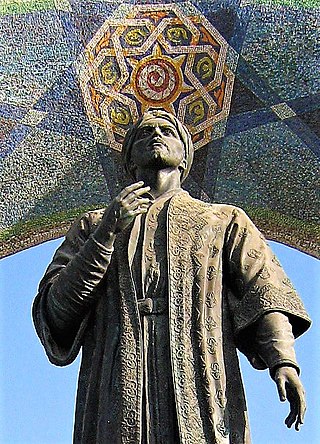Related Research Articles

Rudaki was a poet, singer and musician who is regarded as the first major poet to write in New Persian. A court poet under the Samanids, he reportedly composed more than 180,000 verses, yet only a small portion of his work has survived, most notably a small part of his versification of the Kalila wa-Dimna, a collection of Indian fables. Classical Persian sources refer to him by his honourary epiphet as Adam of Poets.

The Samanid Empire, also known as the Samanian Empire, Samanid dynasty, Samanid amirate, or simply as the Samanids, was a Persianate Sunni Muslim empire, of Iranian dehqan origin. The empire was centred in Khorasan and Transoxiana; at its greatest extent encompassing Persia and Central Asia, from 819 to 999.

Abd al-Malik I was amir of the Samanid Empire from 954 to 961. He was the son and successor of Nuh I. His reign was marked by internal strife, with the Turkic slave-soldiers increasing in power. He died after falling from his horse during a game of polo at Bukhara. He was succeeded by his brother Mansur I, who was put on the throne by a faction of ghulams led by the Turkic slave-commander, Fa'iq Khassa.
Nasr I was amir of the Samanids from 865 to 892. He was the son and successor of Ahmad ibn Asad.

Ahmad ibn Ismail was amir of the Samanids (907–914). He was the son of Ismail Samani. He was known as the "Martyred Amir".

Abu Salih Mansur, better known as Mansur I (منصور) was amir of the Samanids from 961 to 976. The son of Nuh I, his reign was characterized by weak rule and perpetual financial troubles. Mansur was notably the first Samanid ruler to the use title of King of Kings (Shahanshah), most likely as a response to his rival, the Buyid ruler Adud al-Dawla, who likewise used the title. He is also known by the sobriquet Amīr-i Sadid.

Nasr ibn Ahmad or Nasr II, nicknamed "the Fortunate", was the ruler (amir) of Transoxiana and Khurasan as the head of the Samanid dynasty from 914 to 943. His reign marked the high point of the Samanid dynasty's fortunes. He was the son of Ahmad ibn Isma’il.

Alp-Tegin, or Alptekin, was a Turkic slave commander of the Samanid Empire, who would later become the semi-independent governor of Ghazna from 962 until his death in 963.

Abu Ali Ahmad Chaghani was the Muhtajid ruler of Chaghaniyan (939–955) and governor of Samanid Khurasan. He was the son of Abu Bakr Muhammad.
Abu Ali Muhammad Bal'ami, also called Amirak Bal'ami and Bal'ami-i Kuchak, was a 10th-century Persian historian, writer, and vizier to the Samanids. He was from the influential Bal'ami family.
Abu 'l-Fadl Muhammad ibn Abi Abdallah al-Husayn ibn Muhammad al-Katib, commonly known after his father as Ibn al-'Amid was a Persian statesman who served as the vizier of the Buyid ruler Rukn al-Dawla for thirty years, from 940 until his death in 970. His son, Abu'l-Fath Ali ibn Muhammad, also called Ibn al-'Amid, succeeded him in his office.
The Mikalid family, also known as the Mikalis, was a prominent Iranian aristocratic family of Khorasan from the 9th century to the 11th century. They were descended from the pre-Islamic nobility of Samarkand.
Abuʾl-Ḥasan al-Qāsim Aḥmad ibn Ḥasan Maymandī was a Persian vizier of the Ghaznavid ruler Mahmud of Ghazni and the latter's son Mas'ud I of Ghazni.
Simjur al-Dawati was a 10th-century Turkic general who served the Samanids. He was the founder of the Simjurid family which would play an important role in the Samanid Empire.
Lili ibn al-Nu'man, also known as Lili ibn Shahdust, was the leader of the Shahanshahvand clan, and also ruled as the second king of the Gilites, ruling from the early 10th-century to 921. He served in high offices under his overlord the Zaydids. In 921, he invaded the territories of Samanids, conquering Damghan, Nishapur and Merv. He was, however, defeated and killed by a Samanid army under Abu'l-Fadl al-Bal'ami and Simjur al-Dawati. Lili was succeeded by Harusindan, who was a Gilite from another clan.
Abu Mansur Muhammad ibn 'Abd al-Razzaq ibn 'Abdallah ibn Farrukh, also simply known as Abu Mansur Muhammad and Ibn 'Abd al-Razzaq, was an Iranian aristocrat who served the Samanids during the most of career, and briefly served as governor of Azerbaijan under the Buyids.
Abu'l-Husain Abd-Allah ibn Ahmad Utbi, better known as Abu'l-Husain Utbi, was an Iranian statesman from the Utbi family, who served as the vizier of the Samanid ruler Nuh II from 977 to 982.
Ibrahim ibn Simjur was a Samanid military officer from the Simjurid family.
The Bal'ami family was a Persian family native to Khorasan and Transoxiana. The most famous members were Abu'l-Fadl al-Bal'ami and his son Muhammad Bal'ami.
Abū ʿAbdallāh Muḥammad ibn Aḥmad Jayhānī, or Abu Abdallah Jayhani, was the Persian vizier of the Samanid Empire from 914 to 922. His lost geographical work is an important source of 9th-century history of Central Asia and Eastern Europe. His son and grandson also served as viziers.
References
- ↑ BALʿAMĪ, ABU’L-FAŻL MOḤAMMAD, C. E. Bosworth, Encyclopaedia Iranica
- ↑ The Samanids, R.N. Frye, The Cambridge History of Iran, Vol. 4, ed. R.N.Frye, (Cambridge University Press, 1999), 152.